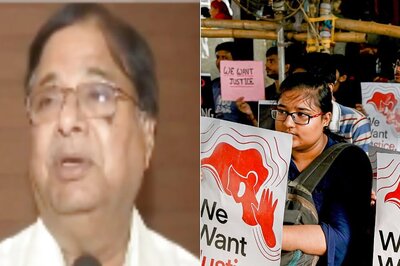
views
Will the firebrand JNUSU student leader Kanhaiya Kumar campaign for the Grand Alliance chief ministerial candidate Tejashwi Prasad Yadav in the upcoming assembly elections in Bihar?
With the three major Left parties — the CPI, CPI(M) and CPI-ML — all set to join the Grand Alliance or Mahagathbandhan led by Rashtriya Janata Dal (RJD) and Congress, speculation is rife that Kanhaiya Kumar may be the star campaigner in a bid to topple the electoral strategy of the NDA.
CPI sources said Kanhaiya is certain to canvas support for the Left parties and also for the Congress and RJD if he is invited to do so.
During the 2019 Lok Sabha elections, efforts were made by the RJD-Congress combine to have an electoral understanding with the Left parties but it did not fructify as the RJD had fielded Tanveer Hassan from Begusarai Lok Sabha seat against Kanhaiya Kumar. Eventually, Kanhaiya finished third behind BJP candidate Giriraj Singh and the RJD in a triangular fight.
As the talks failed, the CPI, CPI(M), CPI-ML, the Socialist Unity Centre of India (Communist) and the Revolutionary Socialist Party had decided to run in all the constituencies on a joint ticket to provide an alternative platform. The CPI had contested on 91 seats, while the CPI-ML fought on 78 seats and the CPI(M) on 38 seats.
However, the CPI-ML reached an understanding with the RJD on the Arrah Lok Sabha seat against Union minister RK Singh. In quid pro quo, the RJD left the Arrah seat for the CPI-ML, which did not field any candidate from the Patliputra seat from where Lalu Prasad’s daughter Misa Bharti fought unsuccessfully against former Union minister of state Ram Kripal Yadav.
The main reason behind the break-up of alliance between the Left parties and the RJD-Congress was the popularity of Kanhaiya Kumar in the aftermath of the JNU controversy. It is understood that Kanhaiya was then perceived as a potential threat to the rise of Tejashwi Yadav.
But this time, the Left parties have broadly conceded Tejashwi Yadav as their chief ministerial candidate. On the flip side, Kanhaiya has been made the national council member of the CPI. He has no stakes as such in the race for the chief minister’s post. Instead, he is maintaining a low profile at the moment after the Delhi government sanctioned prosecution against him in the sedition case.
According to a broad understanding, the RJD will accommodate the CPI-ML and the Vikassheel Insaan Party (VIP) headed by Bollywood set designer-turned-politician Mukesh Sahani. The Congress will accommodate the CPI, CPI(M) and Rashtriya Loktantrik Samata Party (RLSP), led by former Union minister Upendra Kushwaha.
Former chief minister Jitan Ram Manjhi, who heads the Hindustani Awam Morcha (HAM), has already announced to join the NDA. Notably, Manjhi had on August 20 severed his ties with the Grand Alliance after spending two-and-a-half years in the opposition coalition.
The number of seats to be fought by each partner will be decided later during the seat-sharing talks, but the Left parties have become more relevant for the Grand Alliance this time than the caste-based political outfits in Bihar.
“The appeal of political parties having a single-caste base is fast waning as it tends to alienate other castes. The Left parties work at the grassroots level, cutting across caste lines and have support of all castes,” said a senior RJD leader.
The Left parties have come under the spotlight after a long time to prevent the division of the anti-NDA votes. The NDA had assumed political power with a clear victory for the JD(U)-BJP alliance in October-November assembly polls in 2005. The division among the secular democratic parties and the poor administrative record of the previous RJD-led government had triggered popular discontent which was gainfully exploited by the JD(U)-BJP alliance.
“The reasons for the setback to secular parties in a state which had never given a mandate for an alliance that includes the BJP must be gone into so that appropriate lessons are drawn. Now, the Left parties will have a bigger role to play in the secular democratic alliance,” said Santosh Sahar of the CPI-ML.
Though the Left parties have never assumed power in Bihar, they have been at the centre-stage of state’s politics since the first democratic elections in 1952. Their legislative journey had been full of ups and downs as they gained relatively small number of seats in the 1951-52, 1957 and 1962 elections compared to the Congress, but each time it was enough for them to be the principal opposition party.
In the first assembly elections in 1952, the Forward Bloc (Marxist Group) had contested 34 out of the 330 assembly seats, but it could only win one seat. The Congress had garnered over 72 percent seats followed by the Socialist outfits and the Jharkhand Party.
The CPI made its presence felt in the 1957 assembly elections by winning seven out of the 60 seats it contested. In the 1962 assembly elections, the CPI contested 84 seats and won 12 seats. In 1967 assembly elections, the CPI won 24 seats, while the CPI(M) won four seats. The political turmoil led to elections just after two years in 1969 in which the CPI won 25 seats and CPI(M) three seats.
It had emerged as the main opposition party against the Congress in the Bihar assembly in the 1972 assembly elections with 35 seats, leaving the Socialist outfits behind in terms of legislators’ tally. In 1977, the CPI won 21 seats and the CPI(M) four seats. In 1980 and 1985 elections, the CPI won 23 and 12 seats, and the CPI(M) won six and one seat, respectively.
The 1990 assembly elections saw the emergence of two diametrically opposite political streams in Bihar’s politics — the advent of Lalu Prasad Yadav and participation of the hitherto underground Naxal group CPI-ML in the elections for the first time with its over-ground outfit called the Indian People’s Front (IPF).
While Lalu’s arrival heralded the beginning of caste-based politics, the IPF represented the extreme Left philosophy of annihilation of the class enemy. The IPF won seven seats, especially in central Bihar, while the CPI and CPI(M) won 23 and six seats, respectively. Another Leftist outfit, the Marxist Coordination Committee, won two seats.
In 1995, the CPI and CPI(M) won 26 and six seats, respectively, while the IPF started contesting elections in the name of CPI-ML and won six seats. The CPI-ML still has stronghold in Bhojpur and Magadh region and has considerable presence among the Extremely Backward Caste (EBC) votes and the Dalit community.
At present, the CPI-ML is the only Left party having presence in the Bihar assembly with three MLAs representing Darauli, Tarari and Balrampur. Some parliamentary and associated legislative seats like Motihari, Madhubani, Begusarai, Munger, Hazaribagh, Ara, and Patna were considered the bastion of the CPI, CPI(M) and the CPI-ML.
From late 60s to early 90s, the Left parties particularly the ultra-Left outfits have played a crucial role in several successful political movements, bringing changes in the socio-political milieu of Bihar. But the Left politics gradually sunk into the vortex of social justice politics after the emergence of Lalu Prasad Yadav on the political firmament of Bihar.
Now, the Left parties are making efforts to sail with the tide riding the RJD bandwagon to restore their electoral presence.

















Comments
0 comment